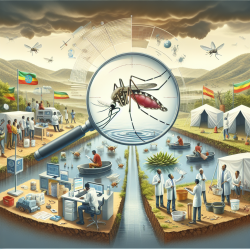The 2019 dengue fever outbreak in Gewane District, Afar Region, North-East Ethiopia, provides critical insights into the epidemiological, entomological, and climatological factors that can inform effective prevention and control strategies. This blog explores the key findings from this research and suggests ways practitioners can apply these insights to improve their skills and encourage further research.
Understanding the Outbreak
The study identified 1,185 dengue fever cases in Gewane District over a three-month period. The majority of cases were among individuals aged 15-49, with symptoms including fever, headache, and joint pain. Notably, mosquito species Aedes aegypti were found breeding in common household containers like plastic tanks and tires. High rainfall in July 2019 and the use of uncovered water storage containers were significant contributors to the outbreak.
Key Takeaways for Practitioners
- Vector Control: The study emphasizes the need for targeted vector control activities focusing on Aedes aegypti. Practitioners should prioritize removing or covering water-holding containers to reduce mosquito breeding sites.
- Entomological Surveillance: Improved surveillance is crucial for early detection of potential outbreaks. Regular monitoring of mosquito populations can help identify high-risk areas.
- Climate Data Utilization: Understanding climatic patterns such as rainfall and humidity can aid in predicting dengue outbreaks. Practitioners should integrate climate data analysis into their public health strategies.
Encouraging Further Research
This study highlights the importance of continued research into the factors influencing dengue outbreaks. Future research could explore the effectiveness of different vector control methods or investigate the role of community education in outbreak prevention.










